Book contents
- Frontmatter
- Dedication
- Contents
- List of Contributors
- Preface
- 1 CMOS technology scaling and its implications
- 2 FinFETs: from devices to architectures
- 3 FDSOI technology and its implications for analog and digital design
- 4 Challenges and emerging trends of DSP-enabled frequency synthesizers
- 5 Digitally-assisted design of data converters
- 6 CMOS self-healing techniques for calibration and optimization of mm-wave transceivers
- 7 Analog-assisted digital design in mobile SoCs
- 8 Digitally-assisted RF design techniques
- 9 Digital controllers for switching power converters
- Appendix A
- Appendix B
- Index
- References
1 - CMOS technology scaling and its implications
Published online by Cambridge University Press: 05 August 2015
- Frontmatter
- Dedication
- Contents
- List of Contributors
- Preface
- 1 CMOS technology scaling and its implications
- 2 FinFETs: from devices to architectures
- 3 FDSOI technology and its implications for analog and digital design
- 4 Challenges and emerging trends of DSP-enabled frequency synthesizers
- 5 Digitally-assisted design of data converters
- 6 CMOS self-healing techniques for calibration and optimization of mm-wave transceivers
- 7 Analog-assisted digital design in mobile SoCs
- 8 Digitally-assisted RF design techniques
- 9 Digital controllers for switching power converters
- Appendix A
- Appendix B
- Index
- References
Summary

- Type
- Chapter
- Information
- Publisher: Cambridge University PressPrint publication year: 2015
References
- 5
- Cited by



